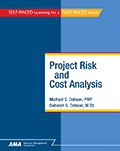Project Risk and Cost Analysis
Authors: Michael S. Dobson, Deborah Singer Dobson
Credit: 2.0 CEUs
Testing Format: multiple choice
Your Price: $159.00
ISBN: 9780761214922
Format: Spiral/Comb/Coil Binding
Overview
In this Self-Study course, Project Risk and Cost Analysis, we will focus on risk in the context of project management, primarily in the area of risk’s effects on project costs, with emphasis on the many modern tools that help you and your organization quantify and manage project risk. We will follow the basic project risk management approach as laid out in A Guide to the Project Management Body of Knowledge (PMBOK® Guide), 4th Edition, popularly known as the PMBOK® Guide, along with other sources listed in the bibliography and suggested reading. Selected Learning Objectives: You will learn how to: – perform a formal risk and cost analysis -apply the Earned Value Method to risk management -and adjust schedule and budget reserves appropriately for your project conditions.
Testing Format
This course contains one multiple choice test valued at 2 CEU’s (continuing education units).
Table of Contents
Contents
About This Course
How to Take This Course
Introduction
Pre-Test
Chapter 1: Introduction to Project Risk and
Cost Analysis
Learning Objectives
Fundamental Concepts of Risk and Risk Management
Risk Defined
The Value of a Risk
Types of Risk
Risk Management Defined
Cost Analysis and Risk Management Planning
Recap
Review Questions
Chapter 2: Risk Identification
Learning Objectives
Identifying Risks
Risk Register
Risk ID
Description of Risk
Category of Risk
Where Found?
Probability of Occurrence
Nature and Degree of Impact
Risk Rating
Disposition
Comments
How to Identify Risks
Systematic Risk Identification
Documentation
Brainstorming
Diagramming Techniques
Checklists
Expert Judgment
Output from Risk Identification Process
Recap
Review Questions
Chapter 3: Qualitative Risk Analysis 37
Learning Objectives
Introduction to Risk Analysis
Qualitative Risk Analysis
Quantitative Risk Analysis
Qualitative Risk Analysis
Start
Impact
Probability
Urgency
Ownership
Solution
Acceptability
Risk Triage and Other Risk Analysis Processes
Recap
Review Questions
Chapter 4: Tools for Qualitative Risk Analysis 51
Learning Objectives
Qualitative Risk Analysis Tools
Assessing Probability and Impact
Establishing Ranges
Risk Thresholds
Combining Probability and Impact
Calculating Risk Scores with Non-Numerical Information
Developing a Risk Ranking for a Project
Updating the Risk Register and Developing a Risk Information Sheet
Recap
Review Questions
Chapter 5: Statistical Foundations of 69
Quantitative Risk and Cost Analysis
Learning Objectives
Quantitative Risk and Cost Analysis Fundamentals
A Statistic
The Law of Large Numbers
Probability, Odds, and Throwing Dice
Basic Rules of Probability
Distribution
Normal Distribution
Measures of Central Tendency: Mean, Median, and Mode
Normal and and Other Distributions
Standard Deviation
Other Types of Distributions
Recap
Review Questions
Chapter 6: Risk Cost Analysis 91
Learning Objectives
Introduction to Cost Risk Analysis
Classical Risk
Risk Cost Analysis
Insurance as a Model for Risk Cost Analysis
Contingency Allowance and Contingency Reserve
Pricing Insurance Risk
Risk Premiums
Insurance Risk with Low Variation
Insurance Risk with High Variation
Additional Factors in Risk Decisions
Black Swan Events
Developing a Final Risk Price
Recap
Review Questions
Chapter 7: Quantitative Cost Analysis Tools 111
Learning Objectives
Quantitative Cost Analysis
Cost Estimating Under Uncertainty
Cost Risk Analysis Tools
Cost-Benefit Analysis
Expected Monetary Value (EMV)
Decision Tree Analysis
Sensitivity Analysis
Recap
Review Questions
Chapter 8: Quantitative Schedule Analysis Tools 123
Learning Objectives
Sensitivity Analysis for Scheduling Issues
Schedule Risk Analysis
Schedule Development
Network Diagramming and Critical Path Analysis
Forward and Backward Pass
Critical Path and Float
Types of Schedule Risk
Three-Point Estimating Techniques
Program Evaluation and Review Technique (PERT)
Monte Carlo Simulation
Recap
Review Questions
Chapter 9: Risk Response Planning 143
Learning Objectives
Organizing for Risk Response Planning
Residual and Secondary Risk
Residual Risk
Secondary Risk
Multi-Stage Solutions
Managing Threats
Avoidance
Transfer
Mitigation
Managing Opportunities
Exploit
Enhance
Share
Managing Acceptance
Contingent Responses
Acceptance
Implementing Risk Response Strategies
Recap
Review Questions
Chapter 10: Risk Monitoring and Control 159
Learning Objectives
Risk Management Processes in Project Execution, Monitoring and
Control, and Closeout
Risk Management Plans and Policies
Risk Management Policy Development
Philosophy, Approach, Scope
Risk Management Methodology and Process
Project Risk Monitoring and Control Systems
Managing the Project Risk Environment
Establishing Risk Metrics and Early Warning Indicators
Earned Value Project Management
Implementing and Monitoring Risk Responses
Corrective Actions and Unplanned Responses
Watching “Watch and Wait” Risks
Change Management and Risk
Planning for Changes
Managing Unplanned Change
Revisiting Risk Identification and Risk Analysis
Closing Risks
Risk Management and Project “Lessons Learned”
Recap
Review Questions
Answers to Exercises and Case Studies 175
Exercise 1-1. Managing Important Risks
Exercise 1-2. Your Current Risk Management Process
Exercise 1-3. What You Spend on Risk Management
Exercise 2-1. Risk Identification Practice
Exercise 2-2. SWOT Analysis
Exercise 3-1. Cause-and-Effect Diagram
Exercise 4-1. Establishing Risk Thresholds
Exercise 4-2. Ranking Risks
Exercise 4-3. Prepare a Risk Information Sheet
Exercise 5-1. Probability Practice
Exercise 5-2. Calculate a Standard Deviation
Exercise 6-1. Greater Accident Variation
Exercise 6-2. Premium Income and Claims Outlays
Exercise 6-3. Pricing Risk
Exercise 7-1. Deterministic or Probabilistic?
Exercise 7-2. Calculating Expected Monetary Value (EMV)
Think About It . . . (Decision Tree)
Exercise 7-3. Decision Tree
Exercise 7-4. Sensitivity Analysis
Exercise 8-1. Critical Path
Exercise 8-2. Scheduling with PERT Estimates
Exercise 8-3. Calculating Standard Deviation for a Path or Network
Exercise 9-1. Risk Response Planning
Exercise 9-2. Residual and Secondary Risk
Exercise 9-3. Types of Risk Response
Exercise 10-1. Earned Value Method (EVM) Performance Index Ratios
Bibliography and Recommended Reading 201
Glossary 205
Post-Test 215
Index 221

